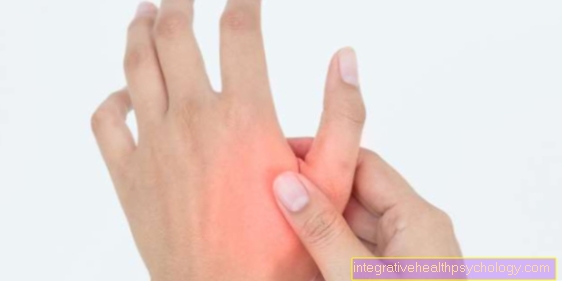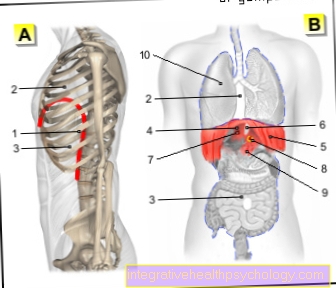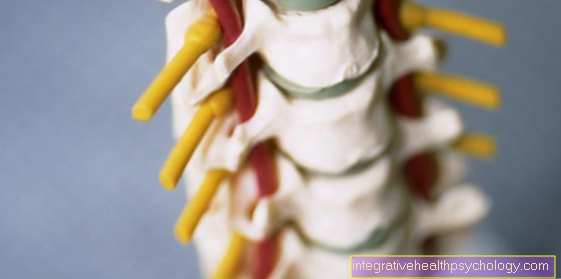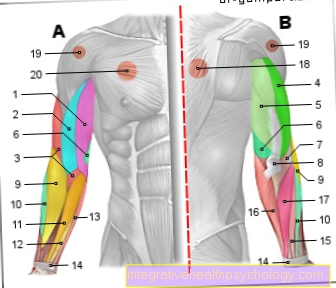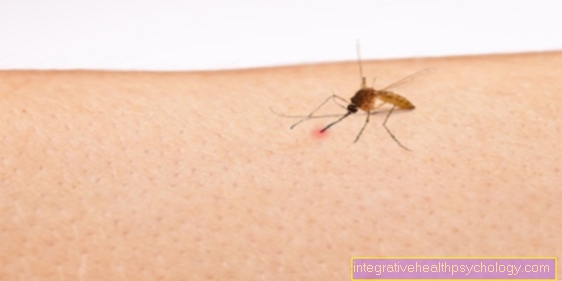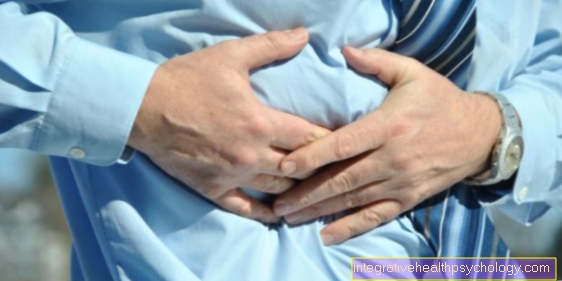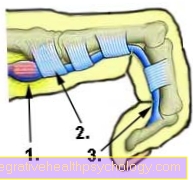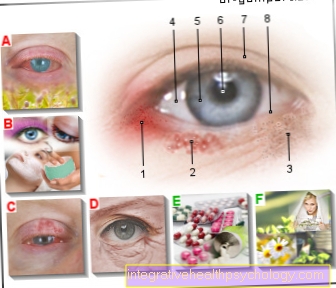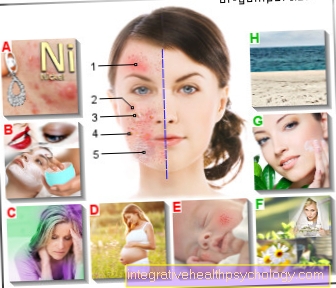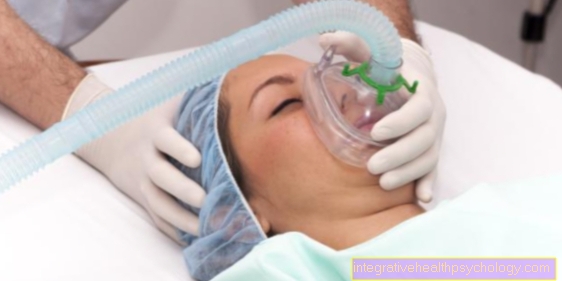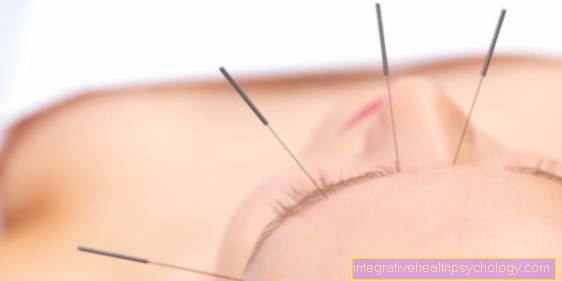Treatment of actinic keratosis
therapy
A variety of methods are available for treating actinic keratosis.
The extent and location of the skin changes are decisive when choosing the appropriate procedure. The cooperation of the patient is also absolutely necessary, since the drug treatment requires long application times and can irritate the skin.

Overview of therapy options
On the one hand, there are the physical therapy methods that have a locally destructive effect and are mainly used for single foci. One method is the so-called kyrotherapy with liquid nitrogen, whereby either the open spray method or the closed contact method is carried out. This therapy is the most widely used therapy, particularly because of its ease of implementation and high cure rates. This is an icing of the affected skin. The painfulness, the occasional reddening of the skin (Erythema) and pigment shift.
Curettage, a scraping with a sharp spoon, is also used, especially if the findings are unclear, as the removed tissue can then be examined. The ablative laser process with the CO2 laser or the erbium: YAG laser, in which the skin is vaporized, is also an alternative.
The disadvantage is that you have to numb the skin as a precaution for this procedure and scars can also occur.
The chemical therapy method available is dabbing with alcoholic podophyllin solution (25%), which has recently been classified as toxic.
Another option is treatment with 5-fluorouracil, a classic chemotherapeutic agent (Cytostatic), which inhibits cell growth. 5-fluorouracil can be applied as an ointment. Unfortunately, application to the skin is often irritating and should last up to eight weeks.
A newer immunological method is the Solaraze gel, a 3% diclofenac gel (pain and anti-inflammatory drug) that suppresses tumor formation by inhibiting prostaglandin E2, a tissue hormone. The long treatment period of three months is a disadvantage.
Another therapy is the Aldara cream, which contains the immunomodulator imiquimod and increases the production of cytokines, i.e. proteins that have a regulating function on the growth and formation of cells. As a rule, the treatment is scar-free.
Read more on the topic: Imiquimod
Freezing with nitrogen
As actinic keratosis is a precancerous stage, early treatment is very important to prevent cancer from developing. Various methods are available for treating actinic keratosis, the use of which is considered individually based on various criteria. One of these procedures is what is known as cryotherapy. In everyday parlance, actinic keratosis is often referred to as “icing over”. The freezing of actinic keratoses is one of the ablative procedures. This means that the actinic keratosis will be removed with the help of the treatment.
As a rule, liquid nitrogen at a temperature of -195 ° C is used as the refrigerant. The liquid can be applied as a spray or with the help of a probe and destroys skin cells suspected of being cancerous, but also healthy skin cells, even with brief skin contact. Depending on the practitioner, the contact time with the skin varies between 5 and 45 seconds. In the case of very pronounced actinic keratoses, a new treatment may be necessary after about 2 weeks. Cryotherapy is suitable for isolated, locally limited actinic keratoses, but not for the treatment of extensive spread.The patients usually do not need any local anesthesia as the procedure is very painless. Slight redness, swelling, pain or blisters can occur as side effects during or after treatment. As a rule, however, cryotherapy is very well tolerated and is therefore very popular with patients.
Laser therapy
Laser treatment is a common procedure in dermatology. The laser is also used in the treatment of actinic keratosis within various therapy methods. The photodynamic therapy leads to a targeted destruction of tumor cells and their precursor cells in the skin. After the administration of a so-called photosensitizing substance such as 5-aminolevulinic acid, the skin is irradiated with a dye laser, among other things, which destroys the cells. Tumor cells and their precursor cells, which form actinic keratosis, enrich the photosensitizing substance more than healthy cells. In combination with oxygen and the dye laser, so-called free radicals are created in the cells. These free radicals destroy the cells. The method is very well tolerated and is also used for the extensive treatment of actinic keratoses. The most common side effects of treatment are redness or pain, but these heal within a few days or weeks without consequences.
Apart from photodynamic therapy, there is also direct laser treatment for actinic keratosis. These are other types of laser, such as CO2 or erbium-YAG lasers, which directly ablate actinic keratosis. They can be used both for the treatment of individual small foci as well as an extensive infestation. In contrast to photodynamic therapy, scars can develop here. As a rule, however, this process is also very well tolerated.
Therapy with creams
Topical, local therapy with creams and gels is of great importance in the treatment of actinic keratosis. In everyday language, creams, gels and ointments are often used synonymously, although this is technically incorrect. Only gels and creams are used in the treatment of actinic keratosis.
An important active ingredient that is used in the form of a gel is ingenol mebutate. A common gel that contains this active ingredient is Picato®, which is available in two concentrations (150 microgram / gram and 500 microgram / gram). In the low dosage, the gel is applied to the head and face area for three consecutive days. The higher dosage is for treating the rest of the body. There the gel is used on two consecutive days.
The drug Solaraze® is a hyaluronic acid gel that contains the active ingredient diclofenac. It is used over a large area in the case of very extensive actinic keratosis. The gel should be used twice a day for a period of two months.
Various active ingredients that are used in the treatment of actinic keratosis are dissolved in creams. A very important example of this is the active ingredient imiquimod (Aldara®, 5%; Zyclara®, 3.75%). The 5% cream is used three times a week for four weeks, while the lower dose is applied daily for two weeks. Apart from imiquimod, the active ingredient 5-fluorouracil can also be found in a cream formulation. The Efudix® cream is applied daily for a period of around three weeks.
Read more about the topics here: Diclofenac gel and Diclofenac ointment
Photodynamic Therapy
Alternatively, photodynamic therapy (PDT) can be used as a combination of a photo stabilizer and subsequent illumination with red light.
First, a cream is made with the ingredient 5-Amino-4-oxo-pentanoic acid methyl ester applied to the skin. This causes certain, particularly light-sensitive substances to form. As a result, the skin cells are sensitized to the subsequent treatment with red light. This creates reactive substances that lead to the death of the affected skin cells.
The high cure rate and the good cosmetic results, as well as the detection of undetected (manifest) Lesions speak for PDT. Uncomplicated feasibility and repeatability of the treatment even with multiple (multiple) Lesions and large areas are an advantage.
Which drugs are useful?
Various drugs are used to treat actinic keratosis, some of which lead to a strong inflammatory reaction in the skin. The drugs are applied externally in the form of ointments or creams to the affected areas and thus develop their effect directly on the skin.
Imiquimod is a very important drug. This is an active ingredient that influences the immune system (immunomodulator) and thus leads to the destruction of the changed skin cells.
Another important active ingredient is 5-fluorouracil. This active ingredient is one of the so-called cytostatics, which are mainly used in cancer therapy. It intervenes in the metabolism of the cells and causes them to die.
The well-known active ingredient diclofenac, which many people are familiar with as a pain reliever, is also used to treat actinic keratosis. Dissolved in hyaluronic acid gel, the active ingredient is applied to the skin, where it influences important enzymes in cell metabolism. '
The drug ingenol mebutate is particularly suitable for short-term therapy of actinic keratosis. It leads to direct cell damage and also promotes an inflammatory reaction in the skin that attacks actinic keratosis.
In the context of photodynamic therapy, drugs, namely so-called photosensitizers such as 5-aminolevulinic acid, are also used. Photosensitizers accumulate in the changed cells of the actinic keratosis and then lead to the destruction of these cells by the subsequent irradiation.
Home remedies for actinic keratosis
Home remedies are popular with most people because of their ease of use.
Unfortunately, there are no effective home remedies for the treatment of actinic keratosis. In the stage of actinic keratosis, the skin cells are no longer healthy. You are developing in a malicious direction. This process cannot be stopped or reversed with home remedies. However, it is possible to alleviate the symptoms by cooling with cold washcloths, etc. to support the therapy. Here you should see which methods are perceived as pleasant.
Homeopathy for actinic keratosis
Actinic keratosis is a precancerous stage of malignant squamous cell carcinoma of the skin. It usually develops after years of exposure to the sun and over time can develop into skin cancer.
So it is very important to take action before the cancer develops. The changed cells can only be removed by medical treatment using various procedures and unfortunately do not heal on their own. A homeopathic treatment is therefore not useful for this clinical picture. Since no time should be wasted, one should therefore refrain from treating first homeopathically and then conventional medicine. However, nothing speaks against the supportive use of homeopathic remedies. Their effect, however, is very controversial and not scientifically proven.
This therapy is funded
Actinic keratosis is a skin disorder that requires treatment, which, if left untreated, can lead to the development of white skin cancer (spinalioma). Actinic keratosis can therefore develop into a potentially life-threatening disease. The treatment is a medical necessity, which is therefore also borne by the health insurance companies. Only a dermatologist can assess which type of treatment is ultimately suitable for the individual case. Depending on the type of health insurer, it may be necessary to submit the treatment plan in order to fully cover the costs. The costs of photodynamic therapy are not fully covered by all health insurances. When using this therapy, the assumption of costs should therefore be clarified in advance. In some cases, however, the statutory health insurance company will also cover at least part of the costs if it can be justified that photodynamic therapy is the method of choice in individual cases. However, the costs for drug therapies, freezing, curettages and operations are easily covered by all health insurance companies


